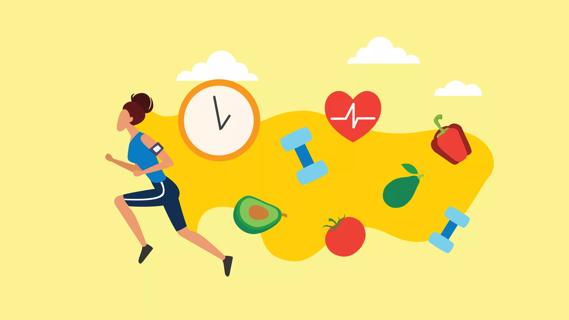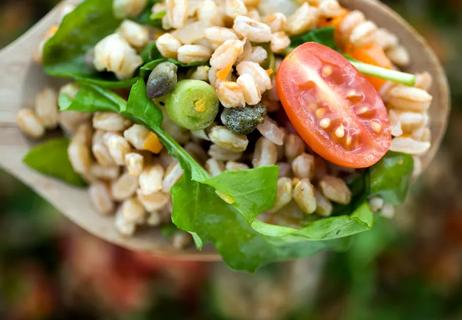Losing belly fat can reduce your risk for chronic health conditions — try focusing on a diet high in lean protein, exercising regularly, reducing stress and getting quality ZZZs

Too often, weight loss advice is focused on all the wrong things. “Trim down for beach season.” Or “Show off those rock-hard abs.”
Advertisement
Cleveland Clinic is a non-profit academic medical center. Advertising on our site helps support our mission. We do not endorse non-Cleveland Clinic products or services. Policy
If you’re carrying extra pounds around your midsection, know that losing belly fat is more than about conforming to unattainable beauty standards. Because the weight we carry in our abdomen can be a sign of health concerns that are more than skin deep.
A round midsection or “apple shape” can be a sign of visceral fat accumulation. And visceral fat is the belly fat that matters most to your health.
Subcutaneous fat lies just under your skin and is what you see in the mirror. But visceral fat goes deeper. It surrounds your organs and can put you at risk for conditions like diabetes, heart disease, polycystic ovary syndrome (PCOS) and more.
The benefits of losing belly fat go far beyond fitting in your high school jeans. Losing belly fat is important to your health.
“We can’t precisely target where we lose every pound of weight, but it’s important to reduce visceral fat,” says psychologist and registered dietitian David Creel, PhD. “By losing 5% to 10% of your body weight, you can improve blood pressure, blood sugar, cholesterol levels, mobility, sexual function and more.”
Dr. Creel shares 14 ways to lose belly fat and improve your overall well-being.
Aerobic exercise burns calories and helps you reduce your total body fat, including belly fat.
Advertisement
“Aerobic exercise gives your metabolism a boost during and for a short time after exercise,” Dr. Creel explains. “Exercise may also have indirect positive benefits on weight, like better sleep and stress reduction.”
Getting your heart rate up can also help build stronger bones, manage your blood pressure and improve your balance, as well as other benefits. (Wins all around!)
For best results, aim for 150 minutes per week of moderate-intensity cardio exercise.
Not sure where to start? Try these exercises to help lose belly fat (and more):
Remember that working out doesn’t have to just be a thing to check off your to-do list. Try to find exercise activities you enjoy. That will make you more likely to stay motivated and stick to your workout routine.
Strengthening your core with exercises like crunches and planks will do your body a world of good.
But maybe not for the reasons you’re thinking.
Strength training is an important component of losing belly fat. But not because it will directly shed pounds.
“When you do sit-ups and other core-strengthening exercises, you’re strengthening muscles in the abdomen, but that doesn’t specifically target the fat or loose skin around the stomach,” Dr. Creel clarifies.
Here’s what it will do, though: Strength training helps build muscle — or at least maintain muscle as you lose fat. And muscle burns calories. So, when you add strength training to your workout routine, you’re giving your body the benefit of burning more calories in between your workouts. That leads to more weight loss in your belly and beyond.
Dr. Creel recommends two to three strength-training exercise sessions per week.
Here are some examples:
Consuming too much added sugar is associated with excess weight that’s likely to accumulate around your waist. So, cutting out sugar (or at least cutting down) can go a long way toward losing belly fat.
Here’s the trick, though: Not all sugary foods are the ones you immediately think of — like candies, cookies and cakes. Of course, those are sugar bombs and should be eaten sparingly. But plenty of other foods contain high amounts of added sugars and may by flying under your radar.
Sneaky sources of sugar to watch out for include things like:
And while we’re on the topic of sugar, don’t forget what you drink. Because high-calorie beverages can impact your sugar intake and settle around your middle as belly fat.
Advertisement
“When we drink our calories, especially with soda or juice, we don’t feel as full or satisfied compared to chewing those calories,” Dr. Creel states. “For instance, you may eat three oranges for the same number of calories as a large glass of orange juice. But the whole oranges will make you feel much fuller for longer than the OJ would.”
Being mindful of cutting back on the calories and sugar in your drinks can help you lose belly fat and save room for more nutrient-dense foods.
And if you think diet soda is the answer, you might reconsider.
“Switching from sugar-sweetened beverages to diet is a step in the right direction for most people with excess weight,” Dr. Creel says. “But we’re still learning about the long-term effects of different low-calorie sweeteners — like the ones found in diet soda — on things like taste preferences, cravings, gut bacteria and insulin resistance, a precursor to Type 2 diabetes.”
Instead, stay hydrated by drinking plenty of water and choosing hydrating foods like cucumbers, celery, watermelon and grapes.
Research shows that people who drink more than moderately may have more belly fat than social or casual drinkers. (The so-called “beer belly.”)
Advertisement
Alcohol can come with a boatload of empty calories. What’s more, imbibing can lower your inhibitions and make it harder to resist less-than-nutritious food choices.
“You may have wings with your beer or cheese with your wine,” Dr. Creel illustrates. “Yes, those things go together, but you’re consuming extra calories and may not be paying attention to what or how much you’re eating.”
Try cutting back on how much alcohol you consume as part of your belly-fat-weight-loss plan. After all, alcohol has negative effects across your body that go far beyond its role in belly fat.
Foods that contain a high amount of soluble fiber can slow down the passage of food from your stomach to your intestine by forming a gummy gel. That means they help you feel fuller for longer.
“If you’re eating foods that are more fibrous, you’re typically eating fewer processed foods in general,” Dr. Creel notes.
Try these high-fiber foods to fill your stomach and help lose belly fat:
Protein helps keep you feeling satiated, lowers hunger hormone levels and may even help you eat less at your next meal, studies show. Protein is also important to building lean muscle, which is important to losing weight, including belly fat.
Advertisement
“It’s not that you need to be on a high-protein diet as much as you should focus on getting adequate protein that’s spread throughout the day,” Dr. Creel says.
He also recommends adding protein when you’re munching between meals. “Snacks are where we tend to overeat. Try having a Greek yogurt or string cheese, which can make you feel more satisfied.”
Try these lean proteins as part of a healthy eating plan to shed belly fat:
Carbs get a bad rap. But not all carbs are bad for you. And choosing the right carbs can help you lose belly fat and keep your body healthy.
Processed carbs have had the fiber stripped away and can cause your blood sugar to spike. They include things like white bread, pasta, chips and crackers.
Complex carbs, on the other hand, can fuel your body with all-important fiber and without negative effects on your blood sugar. They also contain vitamins and minerals that your body needs.
Healthy carb choices include 100% whole-grain bread and pasta, brown rice and beans.
Eating before bed is one of those less-than-healthy habits that a lot of us fall into. But kicking late-night snacking to the curb can be a helpful way to help lose belly fat.
“Some people find it helpful to have a cutoff time for eating, especially at night,” Dr. Creel suggests. “Some people will stop eating after 6 or 7 p.m. because they know nighttime is when they overconsume and engage in mindless eating.”
Here’s why it helps: When you eat during the day, your body burns those calories as you go about your life. But extra calories at the end of the day get stored as fat while you sleep and contribute to weight gain.
Planning ahead can make a big difference in your eating habits. Nutritious meals are important to losing belly fat and keeping your body healthy.
But preparing healthy food can take some time and effort. And sometimes, you just don’t feel like it.
Making meals and healthy snacks in advance sets you up for success and takes the pressure off — halting the cycle of ordering food delivery or relying on convenient, but less nutritious options.
Try these healthy meal prep strategies:
Need more inspiration for meals you can prep in advance? Check out these 75 healthy meal prep recipes.
A good night’s sleep is vital. It can boost your immune system, improve your mood and increase productivity, among other things.
And when it comes to belly fat and weight loss, sleep is supreme. That’s because sleep affects appetite-stimulating hormones.
“When we don’t sleep well or we’re sleep-deprived, it can impact hunger hormones,” Dr. Creel explains. “There’s actually a biochemical response to sleep deprivation that makes us want to eat more.”
Aim for seven hours or more of sleep a night. Prioritize your ZZZs by practicing good sleep hygiene strategies, like turning off electronics an hour before bedtime and sticking to consistent sleep and wake times.
Lowering your stress levels will also help you to lose belly fat.
Here’s why.
If you’re feeling stressed out, your body is likely releasing the stress hormone cortisol into your bloodstream. And there’s a strong link between an increase in cortisol and higher amounts of visceral fat.
But there’s more to the story.
“While cortisol levels play a role, the bigger issue can be that when we’re more stressed, we tend to be less mindful of our eating,” Dr. Creel shares. “It is common for people to turn to food for comfort or to distract themselves from stressful life circumstances.”
Helpful strategies for reducing stress include:
Studies show that keeping a food journal and logging your exercise can set you up for success in achieving your weight loss goals. Logging your nutrition intake and your activities can help you create healthier habits that help you lose belly fat.
“People who self-monitor their food and exercise tend to do better in reaching their goals,” Dr. Creel says. “We don’t know all the reasons why, but what it probably comes down to is awareness and being intentional about our health behaviors.”
Consider using a fitness tracker, like a smartwatch or other device, to help motivate you to lace up those sneakers and take a walk around the block.
Write down what you eat and when to hold yourself accountable for your choices. You can do this with old-school pen and paper. Or search your device for a food-logging app.
Losing belly fat is possible through healthy eating habits and regular physical activity. But our genes, the environment and metabolic processes that defend our weight can create challenges.
And changing your habits is hard. It can even feel overwhelming.
Dr. Creel suggests that talking to a healthcare professional, like a primary care provider or a registered dietitian, can help you figure out where you’re struggling.
Depending on the severity of excess weight and your medical conditions, treatment options might include treatment options like anti-obesity medications or bariatric surgery.
But no matter what treatment path you take, developing a routine and being consistent can help keep you motivated.
“Don’t forget about the benefits of your new behaviors, even if you’re not seeing a lot of weight loss right away,” Dr. Creel encourages. “Small changes can lead to significant health benefits. But it can take time, so patience is important.”
Learn more about our editorial process.
Advertisement

The short answer from a medical weight management expert

It’s best to exercise before or after your fast, instead of during it

If you have low B12 or a true deficiency, these shots can work wonders

Absolutely! In fact, in many ways, exercise is key to recovery

The exercise — which you’ve probably been doing since grade school — can be intimidating, but proper form can help

Cardio is great for improving cognition, but strength and balance training are just as important

Exercise lowers risk for heart conditions, improves mental health and reduces visceral fat that can compromise your organs

Kids’ yoga can help kiddos become more aware of their physical, mental and emotional selves

Type 2 diabetes isn’t inevitable with these dietary changes

Applying a hot or cold compress can help with pain